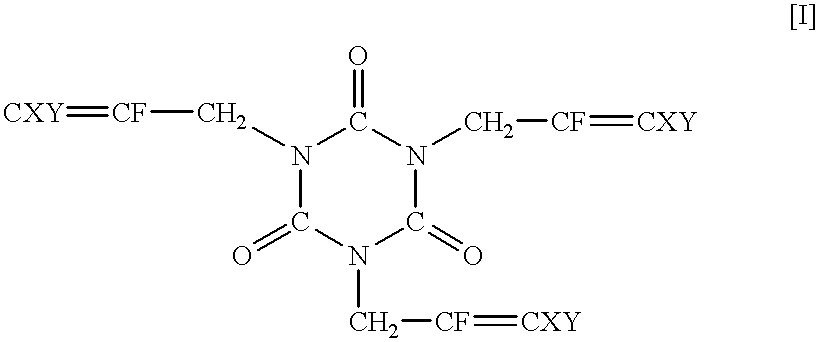Fluorinated triallyl isocyanurates, vulcanizable elastomer compositions containing the same, and method for vulcanization
a technology of vulcanizable elastomer and fluorinated triallyl isocyanurates, which is applied in the field of fluorinated triallyl isocyanurates, vulcanizable elastomer compositions containing the same, and method for vulcanization, which can solve the problems of not always satisfactory heat resistance of cured materials
- Summary
- Abstract
- Description
- Claims
- Application Information
AI Technical Summary
Benefits of technology
Problems solved by technology
Method used
Image
Examples
example 2
Synthesis of 1,3,5-tris(2,3-difluoro-2-propenyl)-1,3,5-triazine-2,4,6-trione
Methyl lithium (1.06 M solution in ether) (175 ml) was dropwise added to the solution of trifluoroallyl alcohol (18.3 g) in diethyl ether (400 ml) at 0.degree. C. over one hour. After 15 minutes, lithium aluminum hydride (6.2 g) was added portion by portion. A reactor was immersed in an oil bath (40.degree. C.), and the content was refluxed for 1.5 hours. The reaction mixture was again cooled to 0.degree. C., and water (24 ml) and the 15% aqueous solution of sodium hydroxide (7 ml) were calmly added to the reaction mixture, followed by drying over magnesium sulfate. After filtration, the solvent was removed, and 2,3-difluoroallyl alcohol (9.5 g) was recovered by distillation under atmospheric pressure.
.sup.1 H-NMR .delta.: 1.96 (1H, t, J=6.5 Hz), 4.40 (2H, ddd, J=21.8, 6.5, 5.3 Hz), 7.08 (1H, dd, J=76.0, 2.9 Hz).
.sup.19 F-NMR (CDCl.sub.3) .delta.: -167.7 (1F, ddt, J=129.7, 2.9, 21.8 Hz), 178.5 (1F, ddt, J=12...
example 3
Homopolymerization of 1,3,5-tris(2,3,3-trifluoro-2-propenyl)-1,3,5-triazine-2,4,6-trione
1,3,5-Tris(2,3,3-trifluoro-2-propenyl)-1,3,5-triazine-2,4,6-trione (82.2 mg, 0.2 mmol), which was obtained in Example 1, and Perhexa 2.5B (3,5-dimethyl-2,5-di-tert.-butylperoxyhexane) (87 mg, 0.3 mmol) were charged in a sample bottle, and the bottle was capped. Then, the sample bottle was placed in an oven at 170.degree. C. After 2 minutes, the content polymerized, and a white solid formed. This period of time was assumed as a polymerization time. The sample bottle was further kept in the oven. After 10 minutes, the sample bottle was removed from the oven and cooled.
The heat resistance of the obtained polymer was evaluated with TG / DTA (RTG 220 manufactured by SEIKO ELECTRONICS Co., Ltd.) The decomposition temperature was 320.degree. C. The measurement was carried out in an air stream of 200 ml / min. by heating a sample from 20.degree. C. to 600.degree. C. at a heating rate of 10.degree. C. / min., a...
example 4
Homopolymerization of 1,3,5-tris(2,3-difluoro-2-propenyl)-1,3,5-triazine-2,4,6-trione
Polymerization was carried out in the same manner as in Example 3 except that 1,3,5-tris(2,3-difluoro-2-propenyl)-1,3,5-triazine-2,4,6-trione (71.4 mg, 0.2 mmol), which had been synthesized in Example 2, was used in place of 1,3,5-tris(2,3,3-trifluoro-2-propenyl)-1,3,5-triazine-2,4,6-trione. a polymerization time was 2 minutes, and A decomposition temperature was 380.degree. C.
PUM
| Property | Measurement | Unit |
|---|---|---|
| temperature | aaaaa | aaaaa |
| temperature | aaaaa | aaaaa |
| temperature | aaaaa | aaaaa |
Abstract
Description
Claims
Application Information
 Login to View More
Login to View More - R&D
- Intellectual Property
- Life Sciences
- Materials
- Tech Scout
- Unparalleled Data Quality
- Higher Quality Content
- 60% Fewer Hallucinations
Browse by: Latest US Patents, China's latest patents, Technical Efficacy Thesaurus, Application Domain, Technology Topic, Popular Technical Reports.
© 2025 PatSnap. All rights reserved.Legal|Privacy policy|Modern Slavery Act Transparency Statement|Sitemap|About US| Contact US: help@patsnap.com



